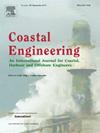Numerical and experimental investigation on ‘C-pile’ breakwaters for wave attenuation
IF 4.5
2区 工程技术
Q1 ENGINEERING, CIVIL
引用次数: 0
Abstract
The growing threat of wave-induced impacts to coastal sustainability necessitates effective wave attenuation strategies. Breakwaters play a pivotal role in mitigating wave energy, with resonant breakwaters leveraging Bragg and localized resonance mechanisms showing significant promise. This study investigates the wave attenuation performance of a novel C-shaped cylindrical (i.e., C-pile) breakwater through physical experiments and numerical simulations. The reflection coefficient, transmission coefficient, and time histories of water levels were measured through wave flume experiments, with the data used to validate a three-dimensional numerical model constructed in OpenFOAM and predictions from Bloch theory based on linear potential flow. Parametric numerical simulations were systematically conducted to explore the effects of opening width, chamber area, opening angle, and submergence depth on the wave attenuation performance and resonance behavior of individual C-piles. Localized optimization of C-pile arrays was conducted to enhance wave attenuation for specific wave period ranges. Results demonstrate that wave attenuation by C-piles is driven by chamber-wave interactions, where fluctuations in water level and volume within the chamber contribute to wave attenuation. The incident wave frequency and the resonant frequency of the C-pile follow a specific relationship. The latter has a close relationship with the structural dimensions. While parametric adjustments improved attenuation for target wave periods, uniform array modifications did not guarantee consistent performance gains. These findings establish the potential of C-piles as effective alternatives to traditional breakwaters, offering insights into resonance-based attenuation mechanisms and tailored optimization strategies.
“c桩”型防波堤波浪衰减的数值与实验研究
波浪对海岸可持续发展的威胁日益严重,因此需要有效的波浪衰减策略。防波堤在减轻波浪能量方面发挥着关键作用,共振防波堤利用布拉格和局部共振机制显示出重大的前景。本文通过物理实验和数值模拟研究了一种新型c形圆柱(即c桩)防波堤的消波性能。通过波浪水槽实验测量了水位的反射系数、透射系数和时程,并用数据验证了OpenFOAM构建的三维数值模型和基于线性势流的Bloch理论预测。系统地进行了参数化数值模拟,探讨了开孔宽度、硐室面积、开孔角度和沉深对单个c桩波衰减性能和共振行为的影响。对c -桩阵列进行局部优化,增强特定波周期范围内的波衰减。结果表明,c型桩的波衰减是由室波相互作用驱动的,其中室内水位和体积的波动有助于波的衰减。c型桩的入射波频率与谐振频率有一定的关系。后者与结构尺寸密切相关。虽然参数调整改善了目标波周期的衰减,但均匀阵列修改并不能保证一致的性能增益。这些发现确立了c型桩作为传统防波堤的有效替代方案的潜力,为基于共振的衰减机制和量身定制的优化策略提供了见解。
本文章由计算机程序翻译,如有差异,请以英文原文为准。
求助全文
约1分钟内获得全文
求助全文
来源期刊

Coastal Engineering
工程技术-工程:大洋
CiteScore
9.20
自引率
13.60%
发文量
0
审稿时长
3.5 months
期刊介绍:
Coastal Engineering is an international medium for coastal engineers and scientists. Combining practical applications with modern technological and scientific approaches, such as mathematical and numerical modelling, laboratory and field observations and experiments, it publishes fundamental studies as well as case studies on the following aspects of coastal, harbour and offshore engineering: waves, currents and sediment transport; coastal, estuarine and offshore morphology; technical and functional design of coastal and harbour structures; morphological and environmental impact of coastal, harbour and offshore structures.
 求助内容:
求助内容: 应助结果提醒方式:
应助结果提醒方式:


